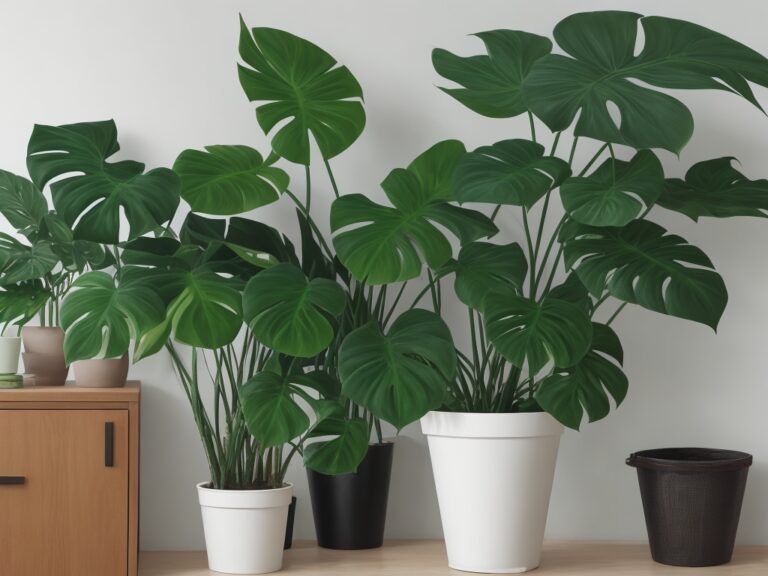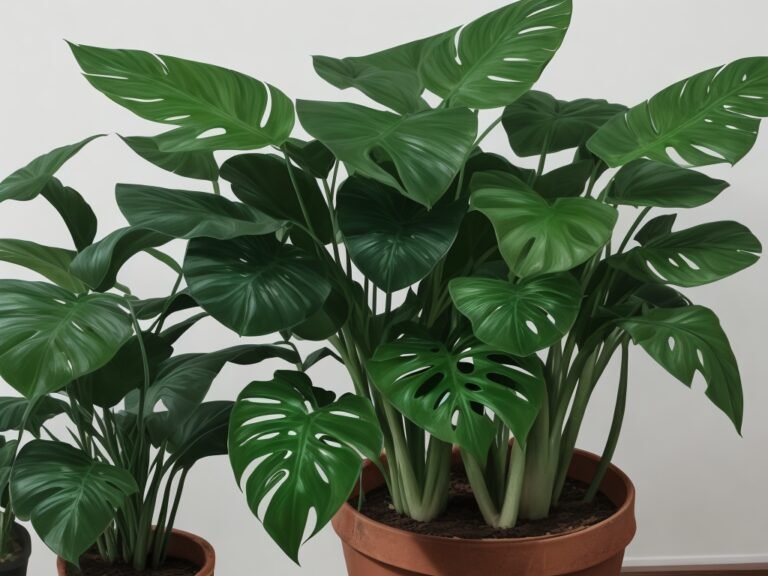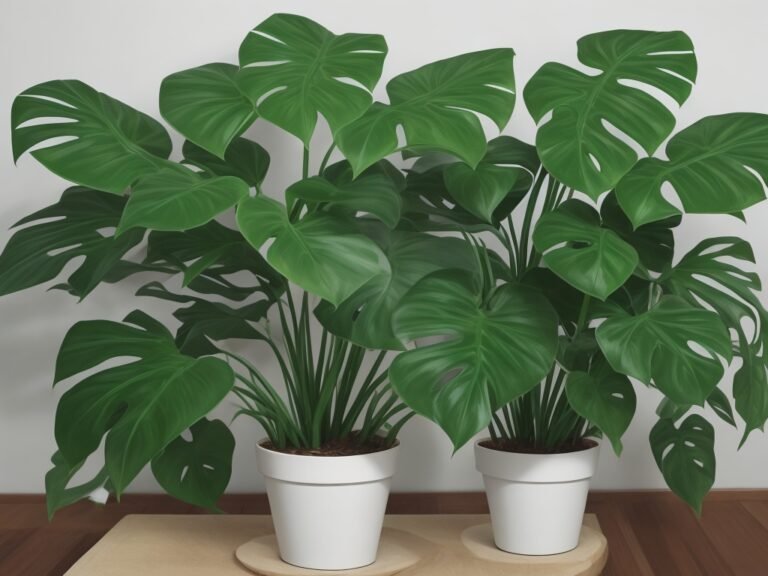Signs It’s Time To Stake Or Prune Your Monstera Plant – Essential Tips!
Key Takeaways:
- Yellowing or browning leaves may indicate it’s time to stake or prune your Monstera plant.
- Overgrown or leggy growth is a sign that your Monstera plant needs staking or pruning.
- If your Monstera plant is taking up too much space or becoming too unruly, it may be time to stake or prune.
- Stunted growth or lack of new growth can signify that it’s time to stake or prune your Monstera plant.
Is your Monstera plant looking a little out of control? It might be time to give it some much-needed attention.
As a plant lover myself, I know how important it is to keep these beauties happy and healthy.
That’s why in this article, I’ll be sharing the telltale signs that it’s time to stake or prune your Monstera plant. From yellowing leaves to overgrown vines, I’ll cover it all.
We’ll also discuss the benefits of staking and pruning, and I’ll provide you with step-by-step instructions on how to do it right.
So, let’s dive in and give your Monstera the TLC it deserves!
| Signs | Action Needed |
| Leaves are drooping or sagging | Stake the plant to provide support |
| Vine is growing too long or unruly | Prune the vine to encourage bushier growth |
| Leaves are turning yellow and wilting | Check for root rot and adjust watering |
| Leaves are touching the ground | Stake the plant or provide a trellis for support |
| Plant is leaning to one side | Stake the plant to straighten it |
What is a Monstera Plant?
A Monstera plant, also known as a Swiss cheese plant, is a popular houseplant with large, glossy leaves that have distinct holes and cuts, adding an attractive and unique touch to any space.
Basic description of Monstera plant
The Monstera plant, also known as the Swiss cheese plant, is a popular houseplant known for its unique foliage. It features large, heart-shaped leaves with distinctive holes and splits, resembling Swiss cheese.
This plant is native to tropical regions and is relatively easy to care for, making it a popular choice among plant enthusiasts.
Monstera plants can tolerate low to bright indirect light, and they prefer well-draining soil. They also have the ability to climb and produce aerial roots, which can be trained to grow along a stake or trellis for added support.
Overall, the Monstera plant is a striking and versatile addition to any indoor space.
Importance of Staking and Pruning
Staking and pruning are essential for maintaining the health and appearance of your Monstera plant.
Benefits of staking and pruning for Monstera plants
Staking and pruning can greatly benefit your Monstera plant.
Staking provides support for climbing aerial roots, encourages upright growth, and prevents weak or drooping stems.
Pruning keeps the plant healthy by removing overgrown or tangled vines, brown or discolored leaves, and encourages new growth.
Signs Your Monstera Plant Needs Staking
If your Monstera plant’s leaves are yellowing or wilting, it may be a sign that it needs staking. Keep an eye out for weak or drooping stems, as this could be an indication that your Monstera plant needs support.
Yellowing or wilting leaves
Yellowing or wilting leaves on your Monstera plant are a clear sign that something isn’t quite right. It could mean that your plant is not receiving enough water or sunlight, or that it has been overwatered.
It’s important to assess the overall health of your plant and make adjustments accordingly.

Weak or drooping stems
Weak or drooping stems in a Monstera plant may indicate a lack of support, which can lead to poor growth and overall plant health.
Staking the plant provides the necessary support to keep the stems upright and strong.

Lack of support for climbing aerial roots
If your Monstera plant’s aerial roots have no support to climb, it’s a sign that you need to stake it. Lack of support can lead to weak growth and prevent the plant from reaching its full potential.
Use a stake to provide stability and encourage upward growth.
Uneven growth or imbalance
Uneven growth or imbalance in a Monstera plant can be a sign that it needs staking.
If you notice that some stems are growing longer and higher than others, it may be time to provide extra support.
Staking will help the plant grow upright and evenly, preventing it from leaning or becoming lopsided.
By providing a stake and gently securing the stems, you can encourage balanced growth and a healthier plant.

Signs Your Monstera Plant Needs Pruning
Your Monstera plant might need pruning if you notice overgrown or tangled vines.
Overgrown or tangled vines
Overgrown or tangled vines are a clear sign that your Monstera plant needs pruning. These vines can become unruly and take over the plant, leading to imbalances in growth and overall aesthetics.
Pruning will help maintain a neat and balanced appearance, and promote healthier growth.
Brown or discolored leaves
Brown or discolored leaves on a Monstera plant can indicate several issues. Overwatering or underwatering, excess sunlight, nutrient deficiencies, or pest infestation are common causes.
To address this, adjust watering habits, provide proper sunlight, fertilize regularly, and inspect for pests.
Pruning affected leaves can also stimulate new growth.
Sudden decline in overall plant health
If your Monstera plant is experiencing a sudden decline in overall health, it may be a sign that something is wrong. This could include issues such as overwatering, underwatering, inadequate light, or pests.
It’s important to assess the plant’s environment and address any problems to help restore its health.
Excessive legginess or sparse foliage
Excessive legginess or sparse foliage in a Monstera plant can be a sign that it needs pruning.
This means that the plant’s stems have grown long and stretched out, with few leaves.
Pruning can help encourage new growth and make the plant more compact and bushy.
How to Stake a Monstera Plant
To stake a Monstera plant, gather materials like a stake, soft ties, and scissors.
Assess the plant’s needs, secure it to the stake, and monitor and adjust the stake as needed.
Gather necessary materials
Here are the materials you’ll need to stake your Monstera plant:
- Stake or support structure: Choose a sturdy stake or structure that can support the weight of your plant.
- Soft ties or plant clips: Use these to secure your plant to the stake without damaging the stems or leaves.
- Pruning shears: These will come in handy for trimming any excess growth before staking.
That’s it! With these materials on hand, you’ll be ready to stake your Monstera plant and give it the support it needs to thrive.
Assess the plant’s needs
Assessing a Monstera plant’s needs involves looking for specific signs that indicate whether it needs staking or pruning. Keep an eye out for wilting or yellowing leaves, weak stems, lack of support for climbing aerial roots, and uneven growth.
These signs indicate the need for staking.
For pruning, watch out for overgrown vines, brown or discolored leaves, sudden decline in plant health, and legginess or sparse foliage. Assessing the plant’s needs helps determine the appropriate action to take for its care.
Properly secure the plant to the stake
To properly secure your Monstera plant to the stake, you’ll want to start by gently attaching the stem or aerial roots to the stake using either soft plant ties or twine.
Make sure not to tie the plant too tightly, as it needs room for growth.
Regularly check the ties and adjust them as needed to provide proper support.
Monitor and adjust the stake as needed
Monitor the growth of your Monstera plant regularly. Check if the stake is providing enough support as the plant grows.
Adjust the stake if necessary to prevent it from becoming too loose or too tight.
Keep an eye on the plant’s aerial roots and make sure they are properly guided and supported by the stake. Regular monitoring and adjustment will ensure that your Monstera plant continues to grow upright and healthy.
How to Prune a Monstera Plant
To prune a Monstera plant, identify areas for pruning, choose the right tools, make clean cuts at the appropriate locations, and properly dispose of pruned plant material.
Identify areas for pruning
Identify areas for pruning by looking for overgrown or tangled vines, brown or discolored leaves, sudden decline in plant health, and excessive legginess or sparse foliage. Inspect the plant carefully to determine which areas need trimming for optimal growth and appearance.
Choose the right tools
To choose the right tools for pruning your Monstera plant, you’ll need sharp, clean pruning shears or scissors. Make sure they’re specifically designed for gardening to ensure they can handle the task.
It’s also a good idea to have a pair of gloves to protect your hands from thorns or irritants.
Make clean cuts at the appropriate locations
To make clean cuts on your Monstera plant, use sharp and clean pruning shears.
Cut just above a leaf node or bud, and avoid cutting too close or too far away.
This will promote new growth and prevent damage to the plant.
Properly dispose of pruned plant material
When it comes to properly disposing of pruned plant material from your Monstera plant, there are a few key steps to follow. First, gather the pruned leaves and stems into a compost bin or bag.
If the pruned material is diseased or infested, it’s important to seal it in a plastic bag and dispose of it in the trash.
Avoid putting diseased or infested plant material in your compost. Remember to wash your hands thoroughly after handling any plant material to avoid spreading any potential diseases or pests.
Frequently Asked Questions about Staking and Pruning Monstera Plants
Can I stake and prune my Monstera plant at the same time?
Yes, you can stake and prune your Monstera plant at the same time. Just make sure you assess the plant’s needs and prioritize the necessary action.
For example, if there are overgrown vines, you can prune them while also providing support with a stake.
Remember to make clean cuts and properly secure the plant to the stake.
Can I use any type of stake for my Monstera plant?
No, you can’t use any type of stake for your Monstera plant.
It’s important to choose a stake that is sturdy, durable, and appropriate for the size of your plant.
Bamboo or wooden stakes are commonly recommended for Monstera plants because they provide sufficient support and blend well with the natural aesthetic.
Metal stakes can also be used, but be sure they won’t rust or damage the plant.
Avoid stakes that are too thin or weak as they won’t provide adequate support.
Is it necessary to prune a Monstera plant?
Pruning a Monstera plant is not necessary, but it can be beneficial for its overall health and appearance. Pruning helps to control its size, remove damaged or unhealthy foliage, and promote new growth.
It also encourages a bushier and more compact shape.
Regular pruning can help maintain the Monstera plant’s vitality and aesthetics.
How often should I stake or prune my Monstera plant?
Staking frequency depends on your Monstera’s growth rate and size.
Check regularly for signs of needing support, like yellowing leaves or weak stems.
Pruning is typically done annually or as needed to remove overgrown or damaged parts.
Monitor your plant’s health and appearance to determine when pruning is necessary.
Final Verdict
Staking and pruning are vital practices for maintaining the health and beauty of your Monstera plant.
By providing support and structure through staking, you can prevent damage to the plant and promote optimal growth.
Pruning helps to keep the plant in shape, remove dead or damaged foliage, and encourage new growth.
By paying attention to signs such as yellowing leaves, weak stems, and overgrown vines, you can identify when your Monstera plant needs staking or pruning.
Following the proper techniques and using the right tools will ensure successful staking and pruning.
Regular monitoring and adjustment will keep your Monstera plant thriving.
Overall, staking and pruning are essential tasks that will help your Monstera plant flourish and bring beauty to your indoor space.






